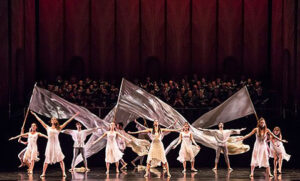
Carmina Burana at the Granada: SB Independent Review
Ballet, Choir, and Symphony Present a Masterpiece
Wednesday, October 21, 2015
by GUSTAVO URIBE

In the land described in the book The Hyborian Age by author Robert E. Howard, a Cimmerian boy, born on the battlefield to a blacksmith, arose to conquer, swearing to a deity called Crom. Conan, as he was named, eventually claimed vengeance on the evil sorcerer Thulsa Doom, infiltrating the Temple of Set as the cult indulged in cannibalistic orgy.
Incidentally, just as pulp-fiction writer Howard wove his tale in the 1930s of Conan — later to be portrayed by Arnold Schwarzenegger on the big screen — Carl Orff, music educator and composer, discovered the medieval sultry poem manuscript Carmina Burana, later to be turned into a 25-song epic masterpiece. Both Conan and Carmina Burana deal with themes of fate, merrymaking, love, warfare, religious worship, and satire. Musically, Orff’s Carmina Burana shares threads of Verdi’s Requiem and Mussorgsky’s Boris Godunov, and later in the 1982 film of Conan the Barbarian, film composer Basil Poledouris’s music score shares the epic choir and medieval soundscape inspired by Carmina Burana.
In 2008, State Street Ballet and the S.B. Choral Society premiered Orff’s full-scale masterpiece, choreographed by William Soleau, at the Granada Theatre. The two groups reunited to again present Carmina Burana on that stage on Saturday-Sunday, October 17-18, but this time they were joined by the S.B. Symphony. To depict the 25-song set in its entirety and maintain storytelling unity is a difficult task; each piece must be able to stand alone and yet flow in stagecraft and narrative continuity. This was achieved with the choir as backdrop, dressed in stage-lit multicolors; bench props rearranged for different utilities throughout the work (pillars, platform, benches); the singing soloists dueting with solo dancers in spotlight; and exploiting the theme of the wheel of fate through clockwise choreography.
The production portrayed the lyrics of Carmina Burana. with a literal Conan the Barbarian, medieval flavor that featured hooded monks emanating creepiness, court jesters, priests, frolicking court dancers, football-field-length dance streamers, and, of course, the choir waving Roman-chariot-like celebration ribbons for the “O Fortuna” finale. The photo-finish highlight of the work, however, was a Théodore Géricault’s The Raft of the Medusa–inspired 12th movement “Olim lacus colueram,” where the beautiful swan glides with melancholy across the stage upon a bench-made-raft platform, to be swarmed, picked, and eaten by a bunch of savages.

 American baritone, Ralph Cato has travelled the world extensively, telling stories in song with his warm, clarion baritone voice.
American baritone, Ralph Cato has travelled the world extensively, telling stories in song with his warm, clarion baritone voice. Tenor, Benjamin Brecher has performed over fifty operatic roles with many of the world’s most prestigious opera companies, specializing in the high lying lyric tenor repertoire. He has performed 16 roles with New York City Opera alone. Career highlights include performances with Opera Orchestra of New York, L’Opera de Nice, Rossini Opera Festival in Pesaro, L’Opera de Montreal, Santa Fe Opera, Opera Theatre of St. Louis, among many others. His orchestral solo repertoire includes Mozart, Handel, Orff, Bach, Haydn, as well as many performances of Britten. In 2000 he began performing the great Irish Tenor songs in a concert produced for him entitled A Celtic Celebration, Twenty years later, the show has become a North American hit with performances with 45 Symphonies in North America. Ben continues his discography having added his twelfth recording in 2016 Forgotten Liszt, with pianist Robert Koenig, and will record a new release in 2022 entitled “Three Centuries of Thomas Moore” including the music of Britten, Berlioz, and Sarah Gibson on MSR Classics. He is a Professor of Voice at University of California Santa Barbara, where he has served as the Head of Voice.
Tenor, Benjamin Brecher has performed over fifty operatic roles with many of the world’s most prestigious opera companies, specializing in the high lying lyric tenor repertoire. He has performed 16 roles with New York City Opera alone. Career highlights include performances with Opera Orchestra of New York, L’Opera de Nice, Rossini Opera Festival in Pesaro, L’Opera de Montreal, Santa Fe Opera, Opera Theatre of St. Louis, among many others. His orchestral solo repertoire includes Mozart, Handel, Orff, Bach, Haydn, as well as many performances of Britten. In 2000 he began performing the great Irish Tenor songs in a concert produced for him entitled A Celtic Celebration, Twenty years later, the show has become a North American hit with performances with 45 Symphonies in North America. Ben continues his discography having added his twelfth recording in 2016 Forgotten Liszt, with pianist Robert Koenig, and will record a new release in 2022 entitled “Three Centuries of Thomas Moore” including the music of Britten, Berlioz, and Sarah Gibson on MSR Classics. He is a Professor of Voice at University of California Santa Barbara, where he has served as the Head of Voice. Born and raised in Southern California, April Amante is a versatile soprano with expertise and facility in repertoire spanning from early music to contemporary musical theater.
Born and raised in Southern California, April Amante is a versatile soprano with expertise and facility in repertoire spanning from early music to contemporary musical theater. Tracy Van Fleet is pleased to return to the Santa Barbara Choral Society. As a soloist, she has performed with the Los Angeles Master Chorale, Lüneburg Symphony in Germany, Orquesta Filarmónica de Boca del Río in Mexico, Pasadena Symphony, Naples Philharmonic, Los Angeles Bach Festival, San Diego Chamber Orchestra, Colorado Philharmonic, USC Symphony and Chorus, and others. She has had many appearances with the Los Angeles Opera, Los Angeles Philharmonic, Pacific Symphony, Hollywood Bowl Orchestra, Opera Pacific, San Diego Opera and Opera Colorado.
Tracy Van Fleet is pleased to return to the Santa Barbara Choral Society. As a soloist, she has performed with the Los Angeles Master Chorale, Lüneburg Symphony in Germany, Orquesta Filarmónica de Boca del Río in Mexico, Pasadena Symphony, Naples Philharmonic, Los Angeles Bach Festival, San Diego Chamber Orchestra, Colorado Philharmonic, USC Symphony and Chorus, and others. She has had many appearances with the Los Angeles Opera, Los Angeles Philharmonic, Pacific Symphony, Hollywood Bowl Orchestra, Opera Pacific, San Diego Opera and Opera Colorado.